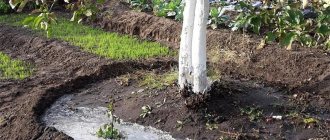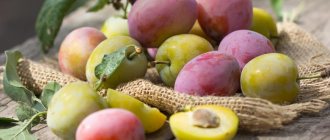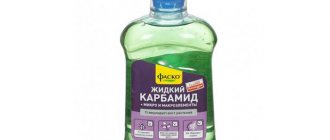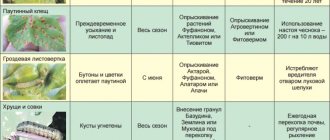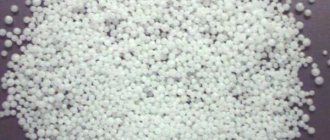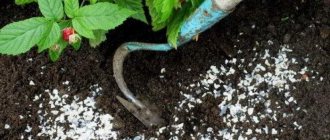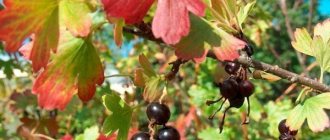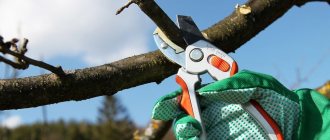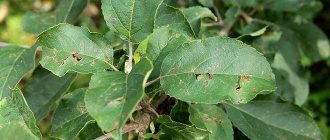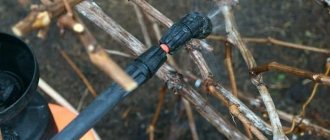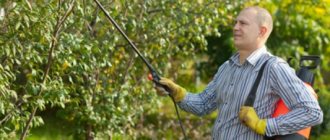In order to enjoy fruits and berries again next year, it is necessary to properly treat the trees and the soil under them from diseases and pests.
Autumn treatment of a garden plot includes sprinkling the crowns of bushes and trees with insecticides and fungicides, digging up the soil, applying fertilizers and protecting plants from small rodents. With the arrival of cold weather, heat-loving crops are additionally covered with spunbond and mulched with sawdust, peat, dry leaves and similar materials.
You should not ignore such procedures if you value the next year’s harvest. If you have never done this, the authors of the site kustroz.ru will help you figure out how and when to properly cultivate your garden in the fall.
When and why is treatment carried out?
Treatment of the garden in the fall against pests and diseases begins when the trees and shrubs lose their leaves. This time occurs at the end of September - beginning of October. For activities, choose a dry, non-rainy day, before early frosts.
The main tasks of autumn treatment: to free trees and shrubs from parasites and their larvae, pathogens, small rodents, and also to preserve plants from the cold. Rake weeds, fallen leaves, and cut branches uphill, collect them and burn them outside the property.
Often insects lay larvae on the lower surface of the leaf, so it is advisable not to bury the foliage in the ground, then you will simplify their task. You should also not leave leaves and straw as a layer of mulch, so as not to attract mice for wintering. Dig up the circles of soil around the trunk well to a depth of 15–20 cm to get rid of pests and their caterpillars overwintering in the soil.
Do this procedure carefully, use a rake so as not to injure the roots of the plantings.
How to treat shrubs against pests in the fall
To treat fruit and berry bushes in the garden, you can use the following preparations and their analogues:
- Break
- Aliot
- Corado
- Rayok
- Green soap
- Alatar
- Akarin
- Aktara
- Trap
- Iskra M
- Herald
- Kinmiks
- Lightning
- Fitoverm Forte
- Commander Maxi
When choosing what to treat shrubs against pests in the fall, carefully read the information about the composition and purpose of the product, since different drugs can be designed to kill different types of insects. Processing must be carried out only in protective equipment - gloves, goggles and a respirator. If you irrigate plants from a garden sprayer, then it is advisable to add a protective suit with rubber boots to this minimum kit. The ammunition must completely eliminate the possibility of contact of any open areas of the body with the insecticide.
Whitewashing plant trunks
Whitewashing the trunks of trees and shrubs will protect the tree from insects and pathogens. Already laid eggs are burned out using whitewashing. In addition, disinfected trunks tolerate frost more easily.
Before starting the activity, lay a cloth around the trees. Use a scraper to free the tree from old bark and moss. Disinfect the surface, treat scratches and cracks on the trunk with garden varnish.
Apply whitewash with a wide brush in a couple of layers to a height of up to one and a half meters. Acrylic or water-based paints are sometimes used as whitewash. Specialized formulations are commercially available. But it’s no wonder to make the mixture yourself. To do this you will need slaked lime, copper sulfate, glue or clay for binding and water.
By adding carbolic acid to the mixture, you protect the garden from hares and rodents.
Spraying the garden
Autumn sprinkling of shrubs and trees is carried out using three main liquids:
- urea,
- copper sulfate,
- iron sulfate.
Remember the protection technique:
- When working in the garden, wear a protective suit, gloves, and a respirator mask.
- Buy a suitable garden sprayer based on the size of the area being treated.
A 5% urea solution will rid the plantings of scab. The trunk and branches of the plant, as well as the soil around it, are subject to treatment against fungal disease. However, do not forget that urea contains nitrogen. This component initiates vegetation processes in trees.
To avoid exposing the plant to frostbite, spray the plantings with urea as close to frost as possible.
Finishing with a solution of iron sulfate (5–7%) will save the garden from moss and lichen, in which insects prefer to lay eggs. In addition, the mixture feeds the bark with iron, which helps in oxidative processes and prepares the plant for wintering.
Stone and pome crops, grapes, currants and gooseberries will be protected from many fungal diseases by a solution of copper sulfate. For greater effectiveness, lime is added to it and Bordeaux mixture is obtained.
Sprinkling trees with Bordeaux mixture is just right in the fall. This composition leaves burns on the leaves, for this reason its use in spring is dangerous. And in the fall, increase the dose of the solution without fear to 3%. Treatment with such a substance is the final stage in the autumn treatment of the site from diseases and pests.
How to spray plants
At this time, gardening shops sell a wide range of specialized formulations (often combined with fungicides and insecticides) for autumn spraying of garden plots. But we will discuss the most popular means.
- Until mid-October, spraying with urea is carried out. In autumn, this is a good medicine to combat fungal diseases, as well as scabs and spots. In addition, urea perfectly burns insect eggs and harms pupae. But there is no need to use urea at the end of the autumn period (closer to winter), since this composition feeds the plant with nitrogen. Urea is very often used as a nitrogen supplement. If you spray the garden with it for the winter, vegetation processes are activated in the plantings. The garden will not have time to prepare for sleep before the cold weather begins and, most likely, will die. For this reason, treating trees with urea in the fall is allowed, but only until the end of October. A month before the onset of frost, there is no need to sprinkle the garden with urea.
- To combat scab, powdery mildew and putrefactive diseases, other fungicides should be used. For example, treating trees with copper sulfate in the fall shows an excellent effect. This product can be used at any time of the year.
- If you add slaked lime to copper sulfate in a 1:1 ratio, you get the so-called Bordeaux mixture - a good composition for parallel combat against diseases and insects. Treating trees with Bordeaux mixture is the most famous type of spraying today. The product has a gentle bluish tone, so if your plantings are wrapped in a film of heavenly color, there is no need to worry. Over time, the color will be removed, but there will be no hostile insects or harmful microbes in the garden.
- Sometimes trees are treated with iron sulfate in areas, mainly in apple orchards. This fungicide works similarly to copper sulfate, only in addition it feeds the vegetation with iron. This is an extremely important trace element for the Apple tribe. It takes an active part in many oxidative processes in apple trees, plums, cherries, and peaches.
Insecticides can be added to copper or iron sulfate. This will give more successful control of insects.
After carrying out all the autumn activities (pruning, treating trees with fungicides, whitewashing, placing insulation and protective equipment), do not forget to clean the planting area. You do not process waste in the form of fallen leaves and trimmed branches, but insect pests can easily live in them and pathogens can breed. For this reason, all garbage must be collected and burned.
How to spray fruit trees?
To spray the garden in autumn you can use:
- inkstone;
- copper sulfate;
- carbamide or urea;
- drug 30B;
- diesel fuel;
- Bordeaux mixture;
- bishal;
- soap-copper emulsion.
inkstone
inkstone
Trees are treated with a solution of iron sulfate either before the beginning of the growing season, or with the beginning of leaf fall. Dissolved in water, this powder helps fight diseases of pome and stone fruit trees, and berry bushes. The effect of iron sulfate is detrimental to moniliosis, spotting, and scab.
To treat the garden, use a 5-7 percent solution of the substance. To prepare the working fluid you need:
- 500-700 g of powder is dissolved in a small amount of warm water;
- after complete dissolution, the volume of liquid is adjusted to 10 l;
- the strained mixture is poured into a sprayer;
- set up a very fine spray;
- Evenly cover the leaves and branches with the solution; it is not scary if some of the liquid gets on the ground. It also needs to be sprayed.
Copper sulfate
Copper sulfate
Copper sulfate or copper sulfate is a recognized fungicide that helps in the fight against spotting, rot, scab, coccomycosis, and lichens.
The working solution of copper sulfate for garden treatment should have a 3-5% concentration. It is prepared in the same way as iron sulfate, only 300-500 g of powder is taken for the same amount of water. Prepare and use in the same way.
Urea or carbamide
The use of urea or urea for autumn garden treatment includes treatment of trees and the soil underneath. The timing of such treatment is the beginning of leaf fall. A strong urea solution can burn out all wintering forms of pests and diseases.
Urea
Procedure for processing trees:
- 700 g of urea or carbamide is dissolved in 10 liters of water;
- process unfallen leaves and tree trunks;
- The tree trunk circle is treated with the same product.
It is necessary to use such a liquid for autumn garden treatment as late as possible. nitrogen, a loading dose of which is contained in the solution, can cause the growth of new shoots. In the spring, there is no need to apply nitrogen fertilizers to trees treated with urea.
Preparation 30v
Insecto-acaricidal “Preparation 30B” destroys wintering pests in the garden and on berry bushes: scale insects, whiteflies, leaf rollers, aphids, mites, moths.
Preparation 30B
The drug disrupts the air and water balance of insects, leading to their death. Pests cannot adapt to the action of the drug; it can be used annually. The advantages of the product include environmental safety, high efficiency, excellent adhesion, and the ability to use the entire season from spring to autumn. The drug has a contact effect, it must be applied without leaving untreated areas.
The drug is very easy to dilute. It is simply dissolved in water and used within the next 2 hours after dilution.
Treatments are carried out at outdoor temperatures above +4°C.
The concentration of the solution for treating trees and shrubs is 3-4%.
The protective effect of the drug lasts from 5 to 10 days. After treatment, you can harvest the crop after 20 days.
Diesel fuel or diesel fuel (DF)
Diesel fuel
Diesel oil is an oily liquid. After treating the tree with such a liquid, an oil film forms on the surface of the bark, destroying pests by clogging their breathing holes.
Diesel fuel, being the result of oil refining, is not considered an environmentally friendly substance, and therefore it is dangerous to use it in the spring. It is best to use this product in the fall; by the time of harvest, it will completely disintegrate and will not remain in the ripened fruits.
Successful recipes for using diesel fuel:
- 1 part of iron sulfate is dissolved in 10 parts of water;
- add 10 parts of lime milk of 10% concentration;
- 20 parts of diesel fuel are added to the resulting mixture;
- the resulting mixture is used to treat plantings after leaf fall.
Another successful recipe:
- 5 parts clay are dissolved in 5 parts water;
- 20 parts of diesel fuel are added to the resulting mixture;
- The resulting emulsion is used to treat the plantings.
Another solution effective in pest control:
- grind 1 part of laundry soap;
- the shavings are dissolved in 9 parts of water;
- 10 parts of diesel fuel are added to the resulting solution;
- We treat the garden with the resulting emulsion.
When using diesel fuel, you need to remember that the density of it and water is very different, and you won’t be able to get a complete solution. When water and diesel fuel are mixed, an emulsion is formed, which very quickly separates into two fractions. Keeping this in mind, when working with such a mixture, you need to periodically shake the solution.
Bordeaux liquid
Bordeaux mixture
Bordeaux mixture is a mixture of copper sulfate and lime in a 1:1 ratio. This mixture destroys foci of diseases (moniliosis, spotting, rot and fungal diseases, scab), and also destroys wintering forms of insects.
To prepare Bordeaux mixture you will need lime, copper sulfate, water, any non-metallic utensils and litmus paper:
- in a non-metallic container, dilute 1 kg of copper sulfate in a small amount of hot water and bring to 50 liters;
- in another container, quench 1 kg of quicklime and dilute the solution to 50 liters, filter;
- immediately before use, both solutions are combined - a solution of copper sulfate is added to the milk of lime (not vice versa).
- the resulting mixture is checked with litmus paper - the reaction of the solution should be neutral;
- for better adhesion of the solution, add 100 g of sugar or 5 cups of paste per 100 liters of liquid;
- The finished mixture can be purchased at a garden store.
Bordeaux mixture should be used in warm, dry, windless weather. Up to 10 liters are used per tree.
Bishal
Bishofit (Bishal)
Autumn and early spring treatment of fruit trees can be carried out using the drug Bishal. This is a solution of the natural remedy bischofite. It contains almost all the microelements necessary for plants.
Depending on the concentration, this solution can be used to treat trees before buds open or before leaf fall, it can be used to treat the garden by green leaf, and it can be used to soak seeds.
Autumn treatment of the garden with a bishali solution will destroy pests preparing for winter, bacterial, viral and fungal infections.
For autumn treatment, bishal is diluted in a ratio of 1:10.
Bishal, like urea, burns out all the infection that remains in the crevices of the bark, but unlike urea it contains many essential microelements.
The advantages of bishali include the absence of a waiting period after processing the garden.
Soap-copper emulsion
Another product for autumn garden treatment is soap-copper emulsion. The recipe for making it is very simple:
- 10 g of copper sulfate is dissolved in 0.5 liters of water;
- 100 g of planed laundry soap are diluted separately in warm water;
- a soap solution is added to the solution of copper sulfate, the volume of the mixture is adjusted to 10 l;
- if the water is hard (flakes appear in the solution), you can add 50 g of soda ash.
If there is a high number of overwintering pests or severe infection, the doses of soap and copper sulfate are increased by 2-3 times.
Fruit tree processing
Tilling your garden in the fall is extremely important. A gardener should not forget about the fruit-bearing trees that gave you a harvest. Take care of them. As soon as the foliage begins to turn yellow, it is necessary to apply organic and mineral fertilizers under the tree trunk.
After harvesting the last fruits, you need to carefully inspect the trees, cut off branches broken under the burden of the harvest, cut off unhealthy and dried out shoots, heal wounds and hollows.
Remember! The tool for cutting branches must be sharp and clean.
All cuts must be covered with garden varnish. Clean the hollows well, treat them with copper or iron sulfate and cover them with special garden putty or garden varnish. Before the leaves fall, spray the area - disinfect the fruit-bearing garden from scab - trees with a 4% urea solution.
To do this, dissolve 400 g of urea in 10 liters of water. You also need to spray the ground around the tree. If it is a dry autumn, then it is necessary to water the garden thoroughly and organize barrier furrows to prevent water from flowing down. In an old garden, after rain, peel off the decayed bark from the trunk and main skeletal branches (pests can hide there), remove the hunting belts - burn all these parts.
Do not keep embalmed fruits on trees over the winter; they must be removed and burned. In late autumn, whitewash the trees. It is advisable to do this when the autumn showers have already ended, otherwise all the paint will be washed off. The young garden needs to be protected from small rodents. To do this, place poisoned baits in secluded places, but so that the birds do not try them.
The trunks and main skeletal branches of trees in a young garden must be wrapped in non-woven material or spruce branches. This way mice and hares won't gnaw away the bark.
Remove growth from grafted and dwarf plantings in the garden. Attract birds to the garden - hang feeders for tits, waxwings and bullfinches. In mid-November, mulch the tree trunks with peat.
As soon as the snow falls, trample it around the trees so that mice cannot reach the trunks. Collect snow from the paths and dust the tree trunks. This will protect the tree root system from extreme cold. Treating trees in the fall against pests and diseases is done in this way. If everything is done correctly, then next year's harvest will make you very happy.
Autumn feeding of trees
At this time of year, slurry diluted with water in a ratio of 1:10 and compost are used as organic fertilizers (for trees from 1 to 7 years old - 1.5-2 kg per 1 sq.m of trunk circle, for trees older than 7 years - from 2 to 3 kg), ash at the rate of (100 g per 10 liters of water), humus (1/2 bucket per 1 sq.m of tree trunk circle).
In autumn, fruit trees also need mineral fertilizers, with the exception of nitrogen, which activates growth processes that are undesirable at this time and reduces the winter hardiness of plants. Phosphorus-potassium fertilizer must be applied to the trunk circle of each tree.
For trees under 10 years of age, use 2 tablespoons of superphosphate and 1 tablespoon of potassium chloride per 1 square meter of trunk circle. For trees older than 10 years, feed at the rate of 4 tablespoons of superphosphate and 2 tablespoons of potassium chloride. Feed cherries and plums with 3 tablespoons of superphosphate and 2 tablespoons of potassium sulfate, diluted in 10 liters of water. For each mature tree, use 4 buckets of this fertilizer.
Shrub processing
Autumn treatment of fruit trees and shrubs: in the fall, after harvesting, disinfect currant and gooseberry bushes from anthracosis and powdery mildew. In the raspberry garden, cut off the last fruiting stems on typical raspberries and collect the remaining berries on remontant raspberries.
After harvesting, raspberries should be sprinkled with Bordeaux mixture or its substitutes against fungal diseases. On strawberries in the autumn, sprinkle with 1% Bordeaux mixture against spotting. In the fall, grapes must be properly pruned and wrapped for the winter.
Cultivating the garden will require persistence and free time on your part. However, this is a mandatory set of procedures, without which you will not have to wait for a healthy harvest.
Treatment against diseases and pests
After leaf fall, begin autumn gardening. If you find signs of mold on the trees, spray the plants with a 3% solution of Bordeaux mixture. In order to get rid of the causative agents of coccomycosis, powdery mildew, scab and other common diseases, treat the crowns of trees with urea at the rate of (0.5 kg of urea per 10 liters of water). Also spray the soil around the trees, only with a more concentrated solution (1 kg of urea per 10 liters of water).
Treatment with urea helps destroy pests that overwinter in the top layer of soil and on tree branches
In the fight against pests, loosening the soil with a pitchfork in tree trunk circles to a depth of 20 cm helps. After this procedure, insect larvae appear on the surface of the earth and, accordingly, die during severe frosts.
